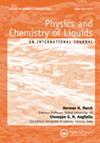Solvatochromic and Acid–Base Molecular Probes in Surfactant Micelles: Comparison of Molecular Dynamics Simulation with the Experiment
IF 1.1
4区 化学
Q4 CHEMISTRY, PHYSICAL
引用次数: 0
Abstract
This article summarizes a series of seventeen publications by the authors devoted to molecular dynamics modeling of various indicator dyes (molecular probes) enclosed in surfactant micelles. These dyes serve as generally recognized tools for studying various types of organized solutions, among which surfactant micelles in water are the simplest and most explored. The modeling procedure involves altogether 50 to 95 surfactant molecules, 16 to 28 thousand water molecules, and a single dye molecule. The presentation of the simulation results was preceded by a brief review of the state of experimental studies. This article consists of three parts. First, despite numerous literature data devoted to modeling the micelles itself, we decided to revisit this issue. The structure and hydration of the surface of micelles of surfactants, first of all of sodium n-dodecylsulfate, SDS, and cetyltrimethylammonium bromide, CTAB, were studied. The values of the electrical potential, Ψ, were estimated as functions of the ionic strength and distance from the surface. The decrease in the Ψ value with distance is gradual. Attempts to consider both DS− and CTA+ micelles in water without counterions result in a decay into two smaller aggregates. Obviously, the hydrophobic interaction (association) of the hydrocarbon tails balances the repulsion of the charged headgroups of these small “bare” micelles. The second part is devoted to the study of seven pyridinium N-phenolates, known as Reichardt’s dyes, in ionic micelles. These most powerful solvatochromic indicators are now used for examining various colloidal systems. The localization and orientation of both zwitterionic and (colorless) cationic forms are generally consistent with intuitive ideas about the hydrophobicity of substituents. Hydration has been quantitatively described for both the dye molecule as a whole and the oxygen atom. A number of markers, including the visible absorption spectra of Reichardt’s dyes, enable assuming a better hydration of the micellar surface of SDS than that of CTAB. However, our data show that it is more correct to speak about the more pronounced hydrogen-bonding ability of water molecules in anionic micelles than about better hydration of the SDS micelles as compared to CTAB ones. Finally, a set of acid–base indicators firmly fixed in the micellar pseudophase were studied by molecular dynamics. They are instruments for estimating electrostatic potentials of micelles and related aggregates as Ψ= 2.303RTF−1 (pKai − pKaapp), where pKai and pKaapp are indices of so-called intrinsic and apparent dissociation constants. In this case, in addition to the location, orientation, and hydration, the differences between values of pKaapp and indices of the dissociation constants in water were estimated. Only a semi-quantitative agreement with the experimental data was obtained. However, the differences between pKaapp of a given indicator in two micellar solutions do much better agree with the experimental data. Accordingly, the experimental Ψ values of ionic micelles, as determined using the pKaapp in nonionic micelles as pKai, are reproduced with reasonable accuracy for the corresponding indicator. However, following the experimental data, a scatter of the Ψ values obtained with different indicators for given micelles is observed. This problem may be the subject of further research.表面活性剂胶束中的溶剂致变色和酸碱分子探针:分子动力学模拟与实验的比较
本文综述了作者在表面活性剂胶束内各种指示性染料(分子探针)分子动力学建模方面发表的17篇系列文章。这些染料是研究各种有组织溶液的公认工具,其中表面活性剂胶束在水中是最简单和探索最多的。建模过程总共涉及50到95个表面活性剂分子,16到28 000个水分子和一个染料分子。在介绍模拟结果之前,对实验研究的现状进行了简要回顾。本文由三部分组成。首先,尽管有大量文献数据致力于胶束本身的建模,但我们决定重新审视这个问题。首先研究了正十二烷基硫酸钠(SDS)和十六烷基三甲基溴化铵(CTAB)两种表面活性剂胶束表面的结构和水化作用。电势的值Ψ是离子强度和离表面距离的函数。Ψ值随距离逐渐减小。试图考虑没有反离子的水中DS -和CTA+胶束会导致衰变成两个较小的聚集体。显然,碳氢化合物尾部的疏水相互作用(结合)平衡了这些小“裸”胶束的带电头基的排斥力。第二部分致力于研究离子胶束中的七种n -苯酚吡啶,即赖克哈特染料。这些最强大的溶剂化变色指示剂现在用于检查各种胶体体系。两性离子和(无色)阳离子形式的定位和取向通常与取代基疏水性的直观观念一致。对整个染料分子和氧原子的水合作用已作了定量描述。许多标记,包括Reichardt染料的可见吸收光谱,可以假设SDS的胶束表面比CTAB有更好的水化作用。然而,我们的数据表明,更正确的说法是阴离子胶束中水分子的氢键能力更明显,而不是SDS胶束与CTAB胶束相比有更好的水合作用。最后,用分子动力学方法研究了一组固定在胶束假相中的酸碱指示剂。它们是估计胶束和相关聚集体静电电位的仪器Ψ= 2.303RTF−1 (pKai−pKaapp),其中pKai和pKaapp是所谓的内在和表观解离常数的指数。在这种情况下,除了位置、取向和水合作用外,还估计了pKaapp值与水中解离常数指数之间的差异。所得结果与实验数据只有半定量的一致。然而,在两种胶束溶液中,给定指示剂的pKaapp之间的差异更符合实验数据。因此,对于相应的指示剂,用非离子胶束中的pKaapp作为pKai测定的离子胶束的实验Ψ值具有合理的精度。然而,根据实验数据,观察到给定胶束的不同指标获得的Ψ值的分散。这个问题可能是进一步研究的主题。
本文章由计算机程序翻译,如有差异,请以英文原文为准。
求助全文
约1分钟内获得全文
求助全文
来源期刊

Physics and Chemistry of Liquids
化学-物理:凝聚态物理
CiteScore
3.30
自引率
8.30%
发文量
43
审稿时长
6-12 weeks
期刊介绍:
Physics and Chemistry of Liquids publishes experimental and theoretical papers, letters and reviews aimed at furthering the understanding of the liquid state. The coverage embraces the whole spectrum of liquids, from simple monatomic liquids and their mixtures, through charged liquids (e.g. ionic melts, liquid metals and their alloys, ions in aqueous solution, and metal-electrolyte systems) to molecular liquids of all kinds. It also covers quantum fluids and superfluids, such as Fermi and non-Fermi liquids, superconductors, Bose-Einstein condensates, correlated electron or spin assemblies.
By publishing papers on physical aspects of the liquid state as well as those with a mainly chemical focus, Physics and Chemistry of Liquids provides a medium for the publication of interdisciplinary papers on liquids serving its broad international readership of physicists and chemists.
 求助内容:
求助内容: 应助结果提醒方式:
应助结果提醒方式:


